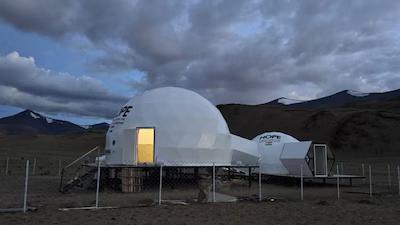
ISRO Sets Up Station in Ladakh to Simulate Life on Moon & Mars
The Indian Space Research Organisation (ISRO) has taken a significant step towards advancing its lunar and Martian exploration missions. The organisation has set up the Himalayan Outpost for Planetary Exploration (HOPE) in Ladakh’s Tso Kar Valley, a region known for its extreme and inhospitable climate. The station will serve as a testing ground for life-support systems for future missions to the Moon and Mars. Two crew members will undertake various tests at the facility from August 1-10, marking the beginning of this ambitious simulation mission.
The Tso Kar Valley was chosen for its unique environment, which bears a striking resemblance to the Martian terrain. The region is characterized by high UV radiation, low atmospheric pressure, extreme cold, and saline permafrost – all of which are similar to the conditions found on Mars. This makes it an ideal location for ISRO to test the equipment and systems that will be used in future Martian missions.
The HOPE station is designed to simulate the harsh conditions that astronauts may face during long-duration space missions. The crew members will have to endure extreme temperatures, which can drop to as low as -50°C, and will have to rely on specialized equipment to sustain themselves. The station is equipped with life-support systems, including air, water, and food supplies, as well as communication equipment and medical facilities.
During the 10-day simulation mission, the crew members will have to perform various tasks, including conducting scientific experiments, testing equipment, and simulating spacewalks. They will also have to deal with unexpected challenges and emergencies, such as equipment failures and medical issues.
The HOPE station is a significant milestone in ISRO’s plans to send humans to the Moon and Mars in the coming years. The organisation has already made significant progress in its lunar exploration program, with the Chandrayaan-1 mission successfully landing on the Moon’s surface in 2008. ISRO is also working on its Mars Orbiter Mission (Mangalyaan), which is scheduled to launch in 2022.
The HOPE station is a crucial step towards ensuring the success of these missions. By simulating the conditions found on the Moon and Mars, ISRO can test and refine its equipment and systems, reducing the risk of failure and ensuring the safety of its astronauts.
The Tso Kar Valley is a unique location for the HOPE station, offering a range of benefits that cannot be replicated in other environments. The region’s extreme climate and barren landscape make it an ideal location for testing the endurance of equipment and systems, while the high altitude and low atmospheric pressure provide a challenging environment for astronauts to work in.
The HOPE station is also expected to play a key role in India’s plans to establish a human settlement on the Moon. ISRO has announced plans to send humans to the Moon by 2025, with the goal of establishing a permanent human settlement on the lunar surface. The HOPE station will provide valuable insights and experience for ISRO’s astronauts, who will have to live and work in a hostile environment for extended periods.
In conclusion, the HOPE station in Ladakh’s Tso Kar Valley is a significant milestone in ISRO’s plans to explore the Moon and Mars. The station will provide a unique opportunity for ISRO to test and refine its equipment and systems, ensuring the success of its future missions. The 10-day simulation mission is just the beginning, and ISRO is expected to continue using the HOPE station to prepare for its ambitious plans to send humans to the Moon and Mars.






